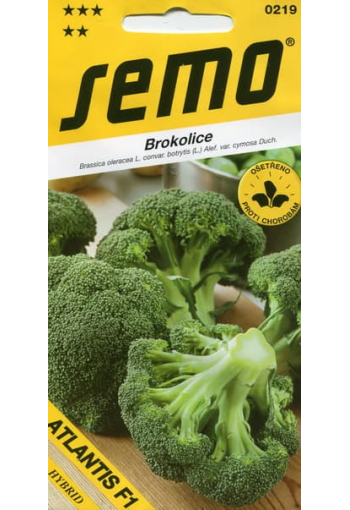Ex Tax: 2.35€
1,0 g = 300 seeds.
Agricultural technology.
The best predecessors are early cucumbers, legumes, onions, root crops and annual herbs.
You can use both seedling and seedless growing methods.
To obtain early production, broccoli is grown from seedlings. Seeds are sown for seedlings several times, starting from March 15. In the phase of 2-3 true leaves, the seedlings are fed. At the age of 40-50 days, seedlings with 4-5 true leaves are planted in open ground.
Seeds are sown in the ground in three terms, starting from the first decade of May. The distance between rows is 60 cm, between plants 20-30 cm. 10 days after planting the seedlings, and also before the formation of heads, broccoli must be fed. Water this crop as needed.
* Broccoli has not only excellent taste but is also a storehouse of vitamins, macro- and microelements:
100 g of broccoli contains: vitamin A - 0.36 mg, C - 89.2 mg, E - 0.78 mg, K - 101.6 mcg, B1 - 0.071 mg, B2 - 0.117 mg, B3 or PP - 0.639 mg, B4 - 18.7 mg, B5 - 0.573 mg, B6 - 0.175 mg, B9 - 63 mcg, calcium - 47 mg, iron - 0.73 mg, magnesium - 21 mg, phosphorus - 66 mg, zinc - 0.41 mg and a small amount of selenium (2.5 mcg), as well as vitamin-like substances, in particular, methylmethionine (vitamin U).
In addition, broccoli is highly valued for the presence in it of substances that control the growth and division of precancerous and cancerous cells.
These are: sulforaphane, sinigrin and indole-3-carbinol. Indole-3-carbinol, for example, is able to activate the immune system in such a way that it itself begins to fight cancer, while sinigrin first inhibits the division of tumor cells, and then simply destroys them.
Eng.: Green Sprouting Calabrese Broccoli. Bot.: Brassica oleracea L. convar. botrytis (L.) Alef var. cymosa Duch.
The word "broccoli" means "little sprouts" in Italian and broccoli is in the same family (Brassica) as Kale, Cauliflower, Brussel Sprouts and others.
Originally the Green Sprouting Calabrese Broccoli is thought to have been introduced into Western vegetable gardens by Italian immigrants in the 1880 s. Green Sprouting Calabrese Broccoli was later introduced to the seed trade between 1914-1918 and has remained very popular with gardeners ever since!
This lovely, old fashioned Broccoli variety is a very disease resistant, very hardy and very prolific producer of 3 to 6 inch, large sized broccoli heads. The heads are a dark green in color, with a tight, bluish green center and are typically uniform in size and shape. The heads of this broccoli variety are not only excellent to the taste, but are very tender, contain few calories and are extremely high in Vitamin A. Once the initial head is cut, many small branches will also appear which will produce small clusters of broccoli sprouts. The plants will grow from 30 to 36 inches in height. Although the heads of this Broccoli variety are typically the only thing utilized, the stalks, buds and leaves are also edible.
Green Sprouting Calabrese Broccoli is very easy to grow and is an excellent crop for cold climates that can be used either fresh or frozen. Matures in approximately 60 to 80 days.
* Broccoli.
In North America, they are very fond of it - it occupies 3 times the area than the colored one.
Moreover, vitamin C in broccoli is 3 times more than in cauliflower, and shoots are much richer in sugars. Young leaves are nutritionally equivalent to spinach, kale.
The plant is rich in carotene. Broccoli heads are essentially ready-made multivitamins and contain salts of potassium, phosphorus, calcium, magnesium.
The content of most essential acids is not inferior to beef. The composition of the protein of this cabbage includes anti-sclerotic substances that prevent the accumulation of cholesterol, which is why it is a sure remedy against premature aging.
Broccoli is a transitional form of leaf-cabbage to cauliflower.
The plant has an increased ability to recover: after the removal of the apical inflorescence, new offspring heads appear in the axils of the leaves (the main thing is that the head must be cut off on time, otherwise it will bloom).











